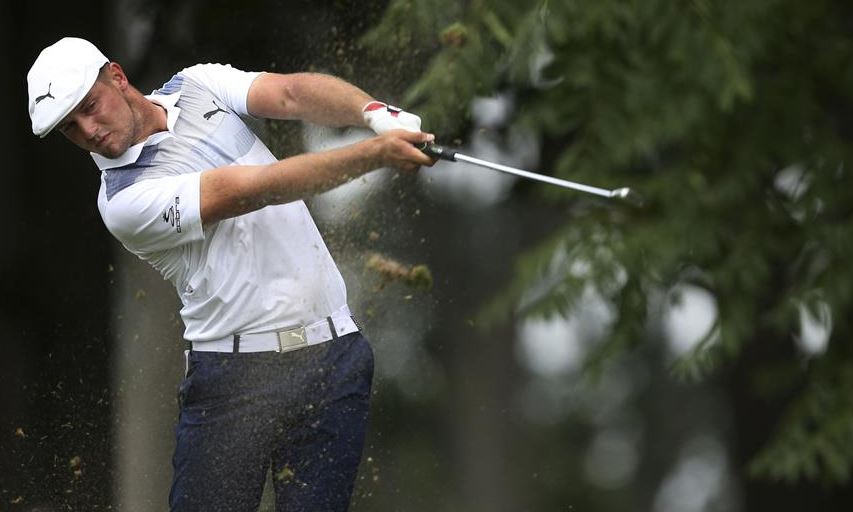Behind Science Of DeChambeau Is A Tireless Worker
- Details
- Category: Inside Golf
- Published: 2018-08-29

By DOUG FERGUSON, Associated Press
PARAMUS, New Jersey — The description of Bryson DeChambeau as a “mad scientist” is appropriate as long as this much is understood.
The scientist is always working, always searching, rarely satisfied.
DeChambeau, without question, is a “different kind of cat.” Those were his words last week after he shot a career-low 63 to take a four-shot lead into the final round, and then missed only two greens and never let anyone closer than two shots at The Northern Trust.
It was his third PGA Tour victory in a little more than a year, moving him to No. 12 in the world and, for the moment, No. 1 in the FedEx Cup.
He does love his science.
DeChambeau talks more about biomechanics than birdies and bogeys.
When he withdrew after the first round of the Valspar Championship in March with an injury, he described it the following week as inflammation of his QL. Perhaps noticing some blank looks, or realizing not everyone speaks the same language, DeChambeau explained.
“It was because my quadratus lumborum wasn’t working,” he said. “My illiacus, longissimus thoracis, they were all kind of overworking, if you want to get technical on that. But they weren’t working very well and I overworked them.”
More blank stares.
“Pretty much my lower right back was hurting and I rested it,” he said. “How about that?”
So this scientist also has a sense of humor.
DeChambeau is the NCAA and U.S. Amateur champion who uses single-length shafts — 37½ inches, or roughly the length of a 7-iron — in all his clubs. He believes it could be revolutionary in golf, and he might be right. He also believes there is more than one way to skin a cat, even a different kind of cat.
Beneath it all is a 24-year-old Californian with a relentless work ethic.
That’s what makes him tick.
Video captured him so frustrated on the range at the British Open that at one point he crouched and put both hands over his face. That doesn’t make him different. It makes him a golfer. He had another long range session on the eve of The Northern Trust. And he worked as long as light would allow Saturday after a 63.
“It’s half of what I do in my off weeks,” DeChambeau said. “People don’t realize how hard I work to try and get a better understanding of my biomechanics. I’ve never really been super talented. People would disagree with that, but I’ve always had to work twice as hard as everybody growing up. I was never as good as a junior. Right around 14, 15, I started working really hard and that’s kind of what changed my game.”
A physics major at SMU, he was asked if he was an A student in high school.
Yes. But he had to work for it.
“I wasn’t great at reading and writing,” DeChambeau said. “But I certainly worked my butt off to be an A student. And I’ll never forget the first time I got a B in high school. I was mortified because I had worked so hard, and I just wasn’t good enough in writing. ... That’s been me my whole life. I’ve had to grind and work it out and figure it out on my own.”
Reading. Writing. Notice he didn’t mention arithmetic.
He smiled.
“Well, that’s a given, I think,” he said. “I do like numbers. I’m more of a theoretical guy than a data-analytics guy. For whatever reason, God has blessed me to see things in just a unique and different way in regards to spatial awareness, if you want to say that.”
No one followed up on spatial awareness.
DeChambeau has found a practice round partner in Tiger Woods, or maybe it was the other way around. They both use the same brand of ball, and Woods always has been intrigued by a different way of playing golf.
During those rounds, Woods has picked up on the essence of DeChambeau.
“We all know he’s extremely intelligent,” Woods said. “But his heart, he gives it everything he has and is always trying to get better.”
It was one year ago when DeChambeau developed a severe callus on the top of his finger, an odd place for it. He attributed it to having oversized grips, the way he holds the club and, of course, long hours. That’s when it was jokingly suggested that he not practice so much.
“Come on. You kidding me?” he said. “Every day that you don’t spend practicing is another day somebody is getting better. That was a quote I took from Hogan.”
Ben Hogan never talked much about spatial awareness, standard deviation and proprioception.
But he knew hard work. Hogan might have liked this guy.



